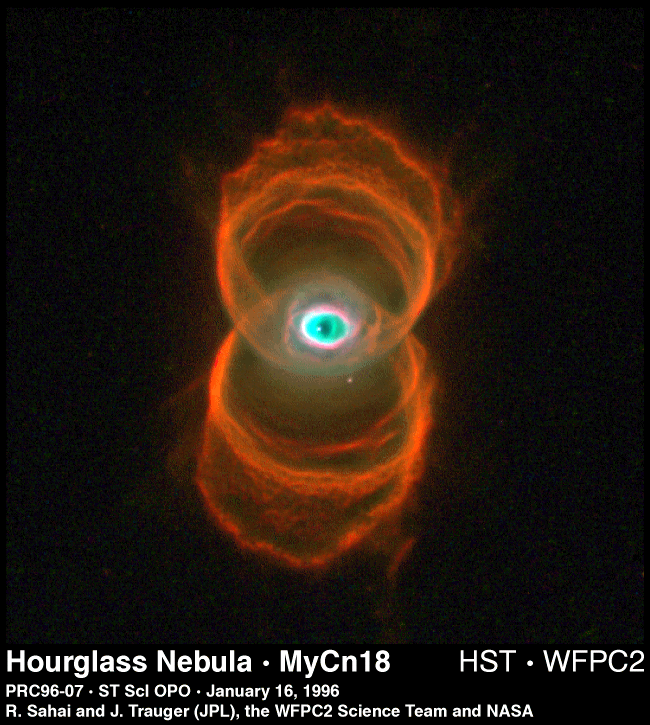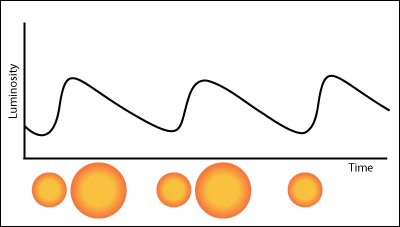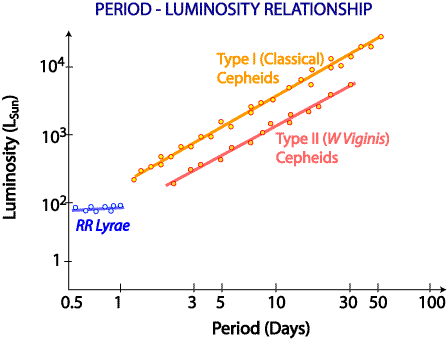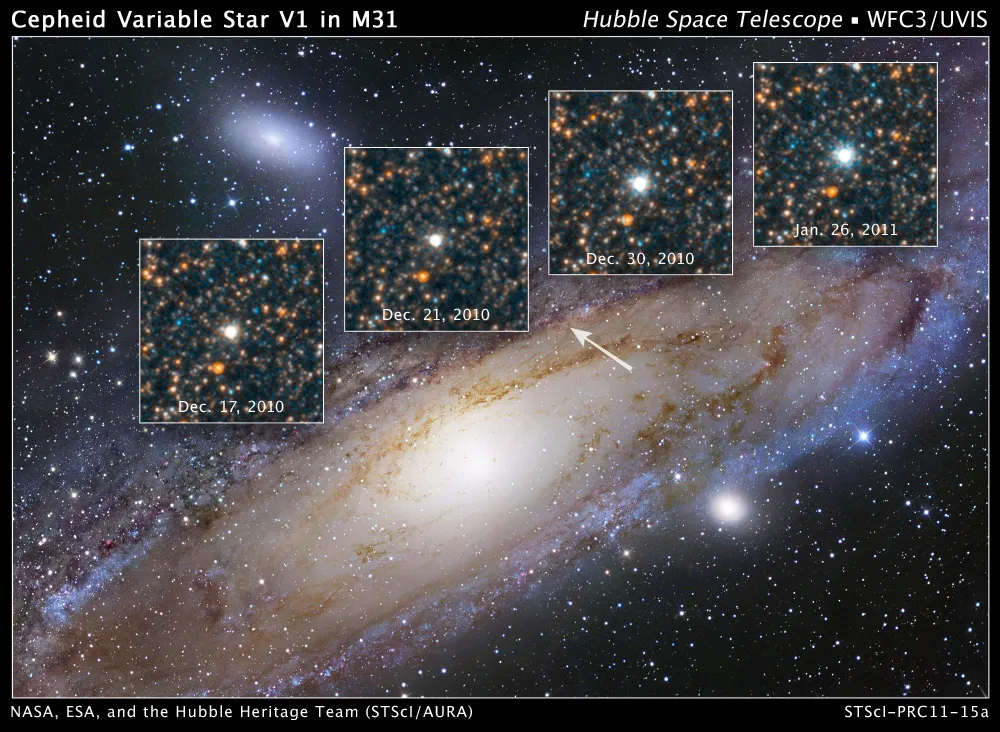Evolution of Low and Intermediate Mass StarsProtostar-->Main Sequence-->Subgiant-->Red Giant--> Horizontal Branch-->AGB-->Planetary Nebula-->White Dwarf-->Black Dwarf |

|
Evolution of Low and Intermediate Mass StarsProtostar-->Main Sequence-->Subgiant-->Red Giant--> Horizontal Branch-->AGB-->Planetary Nebula-->White Dwarf-->Black Dwarf |

|
The evolution of low and intermediate mass stars
is similar to the evolution of high
mass stars. The primary difference
is in how far an individual star moves along the nuclear burning
chain. This then leads to differences in the ways in which the stars end their
lives.

|
(1)-(2). On the Main Sequence, the Sun
converts hydrogen to helium in its core through the
proton-proton chain. Hydrogen is first scoured out
of the center of the Sun where it is hottest and densest.
The helium center then constracts slowly in response causing
the helium center to get hotter and denser. This heats
the overlying layers of hydrogen to higher temperatures and the rate of
nuclear fusion increases.
The increased rate of energy
production causes the overall Sun to get hotter and brighter. This
process continues as the Sun
enjoys life on the Main Sequence. This slow evolution
causes the Sun to move to the left and up
in the HR diagram over its Main Sequence lifetime.
|
The helium flash lasts for a few minutes or less with a peak core luminosity of up to 100 billion LSun. This fantastic power is not observable to an outside observer, however. Why?
The helium flash shuts down because, eventually, as you add enough heat to the gas, you can excite electrons to higher energy states and make the electron gas normal so that the helium burning core expands and so becomes less dense and cooler, thus ending the helium flash.
The helium flash
occurs in stars less massive than around 2.25 M
(5).
After the helium flash, the
star settles into Region (5)
where it quiescently burns what is left
of the helium into carbon and
oxygen (for a time ~ 10 % as long
as its Main Sequence lifetime).
(5)-(7).
After the helium in the Sun's core is converted to carbon and oxygen, the
nuclear reactions again shut down. This causes the core to contract and
heat which also heats the regions adjacent to the core igniting nuclear
burning in two shells, one where helium
is converted into carbon and oxygen
, and another one where hydrogen is converted
into helium. At this time, the Sun expands and cools,
moving to the right in the HR diagram.
When the Sun becomes convective, it moves up the
Asymptotic Giant Branch (AGB) greatly
increasing
in luminosity at roughly constant temperature. During this time the Sun's
core continues to contract trying to reach temperatures high enough to
ignite the carbon and oxygen. Low mass stars like the Sun, however, are not
massive enough to reach the ignition temperature for such burning before the
core becomes completely supported by degenerate electron pressure (which
halts the contraction just as in the protostar
case).
The nuclear evolution of the Sun ends at this point and the star is now ready to enter into its final stages of evolution; at this time the star is AGB star characterized by a carbon-oxygen core, surrounded by a helium burning shell and a hydrogen burning shell.
(7)-(8). At this point, the evolution becomes controversial but current wisdom suggests that the shell burning becomes unstable and a series of nuclear burning pulses can occur. This coupled with the fact that as the outer layers of the star cools, the protons and electrons combine to form neutral hydrogen which produces photons and heats the envelope of the star. These effects combine to eject the outer tens of percents of the envelope of the star at a speed of a few tens of kilometers per second in a few million years.
 |
 |
In the left panel, we see a plot showing the shell luminosity of typical thermal pulses in an AGB star. The shell luminosity more than doubles with outburst intervals of a few hundred thousand years. The pulsing leads to the evolution shown in the right panel. This leads to the formation of Planetary Nebulas, e.g., the Cat's Eye Nebula.
 |
Planetary nebula are emission nebulas which consist of a glowing shell of gas (the outer envelope of the star which has been ionized and energized by the hot central star). They were given their name because they resembled planets when viewed through small telescopes. They are short-lived lasting only tens of thousands of years. There are around 3,000 planetary nebulas known in our Galaxy. Planetary Nebulas are important because they return chemically enriched matter from low-mass stars to the Interstellar Medium, material to be used in the next generations of stars. |
 |
After the hydrogen in the core is used up, the core contracts, and shell burning starts and the Sun cools at nearly constant luminosity. When the Sun becomes convective, it rapidly increases in luminosity at nearly constant temperature and becomes a Red Giant reaching a radius 20 % larger than the Earth's current orbit (1 Astronomical Unit).
During this phase, strong stellar winds cause the Sun to lose ~ 30 % of its mass. Consequently, as the Sun expands, the size of the orbit of the Earth also grows as it spirals out to an orbit of size 1.4 Astronomical Units. Although the Earth may outrace the expanding Sun in this manner, recent work suggests that a tidal interaction between the Earth and the Sun will cause the size of the Earth's orbit to shrink and the Earth to be engulfed by the Sun even when including mass loss.
Without mass loss, the Sun easily expands beyond the orbit of the Earth and the Earth is engulfed. With mass loss, it is closer as noted above, but the Earth will be engulfed during the Red Giant phase.
If the current orbit of the Earth was > 1.15 A.U., we would survive the expansion of the Sun; Mars will survive. After the Helium Flash, the Sun settles in steady helium burning and the Sun shrinks well inside the orbit of the Earth. After helium burning concludes, the core shrinks and the Sun ignites nuclear burning in two shells and the Sun evolves into an AGB star. At the tip ofthe AGB branch, the Sun does not become as large as the Red Giant because it loses more mass to an enhanced stellar wind; 0.4-0.5 of the mass of the Sun is lost by the top of the AGB.
As stars evolve (change their position on the H-R Diagram) they may pass through a region known as the Instability Strip. Here the stars are not in strict hydrostatic and thermal equilibrium. If they remain there long enough, they are observable as pulsating stars. Stars whose masses are larger than 3 to 5 times the mass of the Sun, spend time in the Instability Strip and so become variable stars. The most important types of variable stars are the Cepheid Variables and RR Lyrae stars.
 |
Instability Strip
|

|

|
The Period-Luminosity relationship meant that simply through measurement of the pulsation period of a Cepheid variable, we could infer its average luminosity and so from measurement of its apparent brightness, we could infer the star's distance:

|

|

|
A large uncertainty surrounding the evolution of stars is the question of mass loss (via stellar winds) during the course of their evolution. Low mass stars eventually wind up as white dwarf stars, objects supported by degenerate electron pressure. The maximum mass for a stable white dwarf is around 1.4 M(sun). Since stars of masses up to 8 - 12 M(sun) may form white dwarfs ===> substantial mass loss must occur during the evolution of low mass stars. The rate and timing of the mass loss is not well-known.